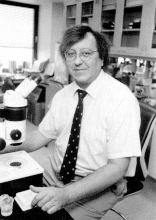Growth Factors in Alzheimer's Disease. Alzheimer's disease is associated with alterations in the regulatory mechanisms governing patterns of cytoskeletal protein expression. Growth factors are responsible for maintaining normal cellular homeostasis and gene expression, and may be critical determinants of the morphologic alterations typically seen in Alzheimer's disease. We have previously demonstrated that bFGF is abnormally increased in Alzheimer's disease. We are currently investigating the role of bFGF and various other growth factors in the pathogenesis of Alzheimer's disease using molecular, biochemical, and morphologic analyses.
Stopa, EG, Volicer, L, Kuo-Leblanc, V, Harper, D, Lathi, D, Tate, B, and Satlin, A. Pathologic evaluation of the human suprachiasmatic nucleus in severe dementia. Journal of Neuropathology and Experimental Neurology 58(1): 29-30, 1999.
Donahue, JD, Berzin, TM, Rafi, MS, Glass, DJ, Yancopoulos, GD, Fallon, JR, and Stopa, EG. Agrin in Alzheimer's disease: Altered solubility and abnormal distribution within microvasculature and brain parenchyma. Proc Natl Acad Sci 96:6468-6472,1999.

Associate Professor
M.D., McGill University, 1980
Rhode Island Hospital
APC, 12-219
444-5155
[email protected]